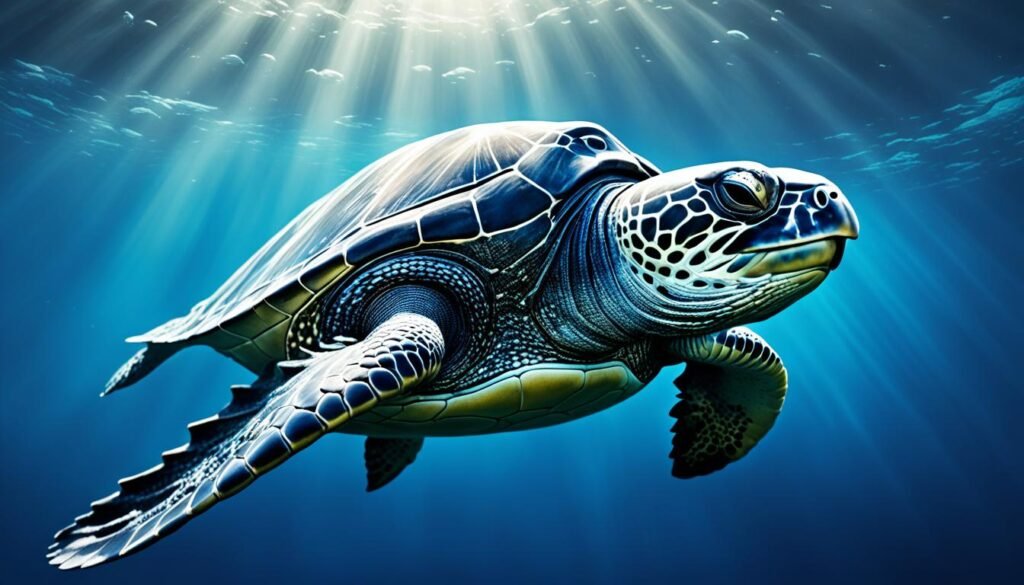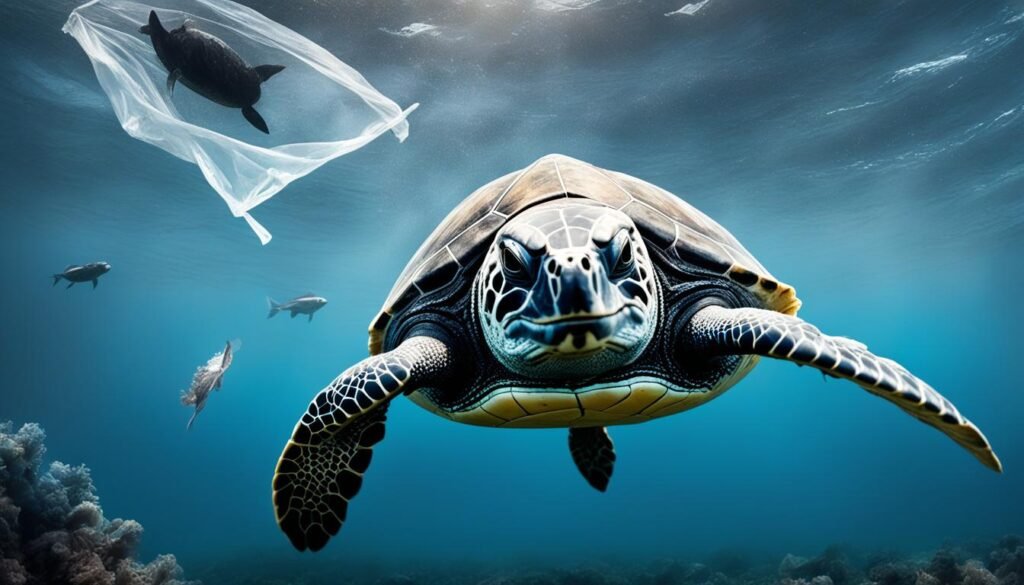Did you know that the Leatherback Sea Turtle, the largest turtle species in the world, can weigh over a ton? These magnificent creatures have been roaming the oceans for millions of years, captivating us with their ancient presence. In this article, we will explore the Leatherback Sea Turtle’s journey, habitat, and the conservation efforts being made to protect these awe-inspiring creatures.
Key Takeaways:
- The Leatherback Sea Turtle is the largest turtle species, weighing over a ton.
- These turtles have been on Earth for millions of years.
- Understanding the Leatherback Sea Turtle’s habitat and migration patterns is crucial for conservation efforts.
- These turtles possess fascinating characteristics, including warm-bloodedness and the ability to dive to great depths.
- Leatherback Sea Turtles face numerous threats, such as pollution and climate change, that impact their survival.
Evolutionary Marvel: A Last-Living Dinosaur
The Leatherback Sea Turtle is often referred to as a living dinosaur due to its prehistoric lineage. It has outlived the dinosaurs and remained virtually unchanged for millions of years. With its unique traits, such as warm-bloodedness and the ability to dive to great depths, the Leatherback Sea Turtle is truly an evolutionary marvel.
The Leatherback Sea Turtle’s ancient lineage and remarkable characteristics make it an intriguing study in evolutionary biology. Its status as a last-living dinosaur is a testament to the incredible adaptability and resilience of these creatures. Through millions of years of evolution, the Leatherback Sea Turtle has perfected its design, making it an ideal ocean voyager.
Prehistoric Lineage
The Leatherback Sea Turtle belongs to the family Dermochelyidae, which first appeared in the fossil record over 110 million years ago. This family of turtles is considered the last surviving group of an ancient lineage that dates back to the time of dinosaurs. The Leatherback Sea Turtle’s ability to survive and thrive in changing environments is a testament to the success of its evolutionary adaptations.
Living Fossil
Living up to its reputation as a living fossil, the Leatherback Sea Turtle has remained virtually unchanged for millions of years. Its unique physiology and behavior have allowed it to persist through the ages with little need for adaptation. The Leatherback Sea Turtle’s warm-bloodedness, for example, enables it to regulate its body temperature in cold waters, unlike other reptiles.
| Key Features | Explanation |
|---|---|
| Warm-bloodedness | The Leatherback Sea Turtle is able to generate heat internally, allowing it to maintain its body temperature in cold waters and dive to great depths. |
| Predator Adaptations | With a beak-like mouth, sharp jaws, and backward-facing spines in its throat, the Leatherback Sea Turtle is well-equipped to capture and consume its jellyfish prey. |
| Diving Abilities | The Leatherback Sea Turtle’s streamlined body, large size, and high lung capacity enable it to dive to depths of up to 4,200 feet (1,280 meters) in search of food. |
As we delve deeper into the world of the Leatherback Sea Turtle, we uncover the marvels of its evolutionary journey. From its origins as a prehistoric creature to its remarkable survival in the present day, the Leatherback Sea Turtle stands as a testament to the incredible forces of evolution and adaptation.
Habitat and Migration Patterns
Leatherback Sea Turtle’s Habitat
The Leatherback Sea Turtle, known for its incredible size and ancient lineage, can be found in both tropical and temperate waters around the world. Its habitat spans three continents and covers vast areas of the ocean, including the Atlantic, Pacific, and Indian Oceans. These turtles have an impressive ability to adapt to various environmental conditions, allowing them to thrive in a range of habitats.
Leatherback Sea Turtles are known to frequent coastal areas with sandy beaches, coral reefs, and seagrass meadows. They are often spotted in regions such as the Caribbean, the Mediterranean, the coasts of Africa, and the Pacific islands. These diverse habitats provide rich food sources, nesting grounds, and breeding sites for the turtles.
Migration Patterns of Leatherback Sea Turtles
Leatherback Sea Turtles undertake impressive migration journeys, traveling thousands of miles across the oceans. These migratory patterns are driven by their need to find suitable feeding and breeding areas. The turtles embark on these long-distance migrations in search of the ideal conditions for survival and reproduction.
One example of their migration patterns is observed in the Pacific Ocean, where female Leatherback Sea Turtles travel from their feeding grounds in the cold waters of Alaska and Japan to the warm tropical beaches in Southeast Asia. This arduous journey covers thousands of miles and requires the turtles to navigate through ocean currents and changing environmental conditions.
The migration patterns of Leatherback Sea Turtles are not only fascinating but also crucial for their survival. By understanding these migration routes and the habitats they depend on, conservation efforts can be targeted to protect these magnificent creatures throughout their incredible journeys.
| Migratory Routes | Distance (in miles) |
|---|---|
| Alaska to Southeast Asia | Approximately 6,000 |
| Canada to West Africa | Approximately 4,200 |
| South Africa to South America | Approximately 3,700 |
Nesting Sites and Reproduction
Leatherback Sea Turtles have a fascinating nesting behavior that showcases their remarkable life cycle. These majestic creatures, with their enormous size and ancient lineage, return to specific nesting sites every few years to lay their precious eggs.
The nesting sites chosen by Leatherback Sea Turtles are carefully selected for their suitability. These sites are typically located on sandy beaches, providing the ideal conditions for the turtles’ reproduction process. The turtles rely on the warmth and softness of the sand to create the perfect environment for their eggs to develop and hatch.
During the nesting process, female Leatherback Sea Turtles dig a deep hole in the sand and lay dozens of eggs. These nests contain multiple chambers, each holding a cluster of eggs. The mother turtle then covers the nest with sand, carefully concealing it from predators.
Fun fact: Leatherback Sea Turtles can lay between 70 to 100 eggs in a single nesting event.
Nesting Behavior
Leatherback Sea Turtles exhibit a strong homing instinct, which means they return to the same nesting sites where they were born. This behavior ensures the continuation of the species by passing down the knowledge of suitable nesting grounds from one generation to the next.
Once the nesting is complete, the female Leatherback Sea Turtle returns to the open ocean, leaving the eggs to incubate and hatch on their own. The eggs are left to the mercy of natural elements and predators, facing various challenges during their incubation period.
Hatching and Survival
The survival of Leatherback Sea Turtle hatchlings is a challenging process. The eggs incubate for approximately 60 days, with the temperature of the sand playing a crucial role in determining the sex of the hatchlings. Warmer sand temperatures typically produce female turtles, while cooler temperatures result in males.
When it’s time to hatch, the baby turtles use a temporary egg tooth to break through the eggshell. They then emerge from the sand and instinctively make their way towards the ocean, following the moonlight reflecting on the water. This journey is dangerous and fraught with potential threats, such as predators and artificial lighting that can disorient the hatchlings.
Did you know? Only about one in 1,000 Leatherback Sea Turtle hatchlings will survive to adulthood.
The nesting sites and reproduction process of Leatherback Sea Turtles highlight the importance of protecting and preserving these critical habitats. By safeguarding nesting beaches and implementing conservation measures, we can ensure the survival of this extraordinary species for generations to come.
Fascinating Facts and Figures

Leatherback Sea Turtles possess several fascinating characteristics. They have the ability to warm their body temperature above that of their surroundings, enabling them to dive to incredible depths. They also have a specialized diet of jellyfish, consuming large quantities every day. Furthermore, Leatherback Sea Turtles face numerous threats to their survival, including pollution, climate change, and human activities.
Unique Adaptations and Behaviors
The Leatherback Sea Turtle’s ability to regulate its body temperature is a remarkable adaptation that allows it to thrive in cold waters. By warming its body, this turtle can withstand lower temperatures and dive to unprecedented depths in search of food.
Another intriguing fact is the Leatherback Sea Turtle’s diet. With their unique morphology and specialized jaws, they are perfectly suited to consuming their favorite prey: jellyfish. These turtles can consume hundreds of pounds of jellyfish each day, playing a crucial role in controlling jellyfish populations and maintaining the balance of the marine ecosystem.
Threats to Survival
Despite their remarkable adaptations, Leatherback Sea Turtles face severe threats that endanger their survival. Pollution, particularly plastic waste, poses a significant hazard as turtles often mistake plastic bags and other debris for jellyfish. Ingesting plastic can be fatal, causing blockages in their digestive system.
Climate change also poses a significant risk to Leatherback Sea Turtles. Rising sea levels and changes in ocean currents affect nesting sites, disrupt the turtles’ migration patterns, and impact the availability of their main food source, jellyfish.
Human activities, including coastal development, excessive fishing, and accidental capture in fishing gear, further threaten the survival of these magnificent creatures. Conservation efforts are essential to mitigate these risks and ensure the long-term survival of Leatherback Sea Turtles.
| Threats | Impact |
|---|---|
| Pollution | Potential ingestion of plastic and other debris, leading to injuries and death |
| Climate Change | Disruption of nesting sites, changes in migration patterns, and reduced availability of jellyfish |
| Human Activities | Habitat destruction, excessive fishing, and accidental capture in fishing gear |
Conservation Efforts and Success Stories
Conservation organizations around the world are dedicated to safeguarding the Leatherback Sea Turtle and its habitats. Through concerted efforts, significant progress has been made in various areas of conservation.
One of the main initiatives is the protection of Leatherback Sea Turtle nesting beaches. These organizations work tirelessly to guard these critical sites, ensuring that they remain free from human disturbance and predators. By preserving and monitoring these nesting beaches, conservationists give the Leatherback Sea Turtles a safe space to lay their eggs and increase the chances of successful hatchlings.
Another crucial aspect of conservation involves reducing bycatch in fishing nets. By collaborating with local fishing communities and implementing measures such as using Turtle Excluder Devices (TEDs) in fishing gear, conservation organizations help prevent accidental capture and drowning of Leatherback Sea Turtles. These innovative solutions have proven effective in minimizing turtle mortality and promoting sustainable fishing practices.
Raising awareness about the importance of Leatherback Sea Turtle conservation is also an essential part of these efforts. By educating the public, schools, and communities about the threats faced by these magnificent creatures, conservation organizations foster a sense of responsibility towards their protection. This increased awareness leads to positive behavioral changes and promotes a more sustainable coexistence with Leatherback Sea Turtles and their habitats.
Success Stories
The conservation efforts in the Atlantic Ocean have yielded positive results, with noticeable increases in Leatherback Sea Turtle populations. Collaborative measures between local communities, governments, and conservation organizations have contributed to the recovery of nesting sites and the growth of turtle populations in this region.
However, challenges remain in the Pacific Ocean, where Leatherback Sea Turtles face multiple threats, including habitat degradation and extensive fishing activities. Ongoing conservation efforts aim to address these challenges and protect the remaining populations of Leatherback Sea Turtles in the Pacific.
Overall, through dedicated conservation efforts and success stories in the Atlantic Ocean, progress is being made in safeguarding the Leatherback Sea Turtle and preserving its presence in our oceans for future generations.
| Conservation Efforts | Atlantic Ocean | Pacific Ocean |
|---|---|---|
| Nesting Beach Protection | Successful | Challenging |
| Reduction of Bycatch | Effective | Ongoing |
| Awareness Campaigns | Positive Impact | Need for Greater Outreach |
| Population Growth | Significant Increases | Declining |
Threats to Leatherback Sea Turtles

Leatherback Sea Turtles face numerous threats that pose significant risks to their survival. It is imperative to understand and address these challenges in order to ensure the long-term conservation of these magnificent creatures.
Habitat Loss: One of the most critical threats to Leatherback Sea Turtles is the loss of their natural habitat. Coastal development, including the destruction of nesting beaches, disrupts their reproductive cycle and hampers their ability to lay eggs.
Pollution: Increasing pollution in the oceans has severe consequences for Leatherback Sea Turtles. They often mistake plastic debris for jellyfish, their primary food source, leading to ingestion and entanglement in marine litter.
Climate Change: The rising temperatures of the oceans pose a significant threat to Leatherback Sea Turtles. It affects their breeding cycles, as well as the distribution and availability of their prey, causing imbalances in their delicate ecosystem.
Poaching: Illegal hunting of Leatherback Sea Turtles and their eggs persist in several regions, driven by demand for their meat, shells, and other products. This illegal trade further exacerbates the population decline of these already threatened creatures.
Accidental Capture: Leatherback Sea Turtles often fall victim to unintended capture in fishing gear, such as trawls, nets, and longlines. This bycatch can result in serious injuries and fatalities, further threatening their already compromised population.
Addressing these threats requires concerted efforts in conservation and preservation. By implementing measures to protect their habitats, reducing pollution and plastic waste, mitigating climate change effects, and enforcing strict regulations against poaching and bycatch, we can safeguard the future of Leatherback Sea Turtles and restore balance to our oceans.
The Size and Population of Leatherback Sea Turtles
Leatherback Sea Turtles are the largest of all turtle species, with adult females reaching lengths of up to 7 feet and weighing over a ton. These magnificent creatures showcase the incredible size and strength that have captivated researchers and nature enthusiasts alike.
However, despite their impressive size, Leatherback Sea Turtles face a significant threat to their population. In recent decades, their numbers have experienced a sharp decline, particularly in the Pacific Ocean. This worrisome trend calls for urgent action to protect and preserve these magnificent ocean voyagers.
Efforts are underway to monitor and safeguard the remaining populations of Leatherback Sea Turtles. Researchers and conservation organizations are working tirelessly to understand the factors contributing to their decline and implement effective measures to ensure their survival.
Through research, education, and conservation initiatives, we can make a difference in the future of Leatherback Sea Turtles. By understanding their size, population dynamics, and the challenges they face, we can develop strategies to mitigate threats and support their recovery.
The Importance of Leatherback Sea Turtles
Leatherback Sea Turtles play a vital role in the marine ecosystem. As top predators, they help maintain the balance of marine populations, particularly jellyfish. Their presence also indicates the health of marine habitats. Protecting and conserving Leatherback Sea Turtles is not only important for their survival but also for the overall health of the oceans.
Role as Top Predators
Leatherback Sea Turtles occupy a crucial position in the food chain as top predators. They feed mainly on jellyfish, whose populations can rapidly increase if not controlled. By consuming large quantities of jellyfish, Leatherback Sea Turtles help control their numbers, preventing ecosystem imbalances and potential disruptions to the food web.
Indicator of Ecosystem Health
The presence of Leatherback Sea Turtles in marine habitats is an indicator of ecosystem health. These turtles require healthy and thriving habitats to survive. A decline in Leatherback Sea Turtle populations can signify environmental degradation, pollution, or other disturbances that impact the overall well-being of the ecosystem. Monitoring and conserving these turtles can provide valuable insights into the status of marine habitats and guide conservation efforts.
| Leatherback Sea Turtle’s Role | Benefit |
|---|---|
| Top Predator | Controls jellyfish populations |
| Ecosystem Indicator | Signifies overall ecosystem health |
Conclusion
The Leatherback Sea Turtle is a magnificent and ancient creature that continues to captivate us with its size and unique characteristics. As we have explored in this article, these turtles have been swimming in our oceans for millions of years, surviving the test of time and remaining virtually unchanged.
However, their future is far from certain. Leatherback Sea Turtles face numerous threats that put their survival at risk. From habitat loss to pollution and climate change, these majestic creatures need our urgent attention and conservation efforts.
By understanding their habitat, migration patterns, and reproductive behaviors, we can take significant steps towards protecting and conserving Leatherback Sea Turtles. It is our responsibility to ensure the continued existence of these magnificent ocean voyagers for generations to come.
Let us join forces and work together to safeguard their habitats, reduce pollution, and promote sustainable fishing practices. By doing so, we can contribute to the conservation of Leatherback Sea Turtles and protect the fragile balance of our marine ecosystems.
FAQ
What is the Leatherback Sea Turtle?
Where are Leatherback Sea Turtles found?
How do Leatherback Sea Turtles reproduce?
What are some fascinating facts about Leatherback Sea Turtles?
What conservation efforts are being made to protect Leatherback Sea Turtles?
What are the threats to Leatherback Sea Turtles?
How big are Leatherback Sea Turtles?
Why are Leatherback Sea Turtles important?
References
| Organization Name | URL |
|---|---|
| International Reptile Conservation Foundation (IRCF) | https://www.ircf.org/ |
| Herpetological Conservation International | https://herpconservation.com/index.html |
| Society for the Study of Amphibians and Reptiles (SSAR) | https://ssarherps.org/conservation/conservation-resources/ |


2 thoughts on “Leatherback Sea Turtle: Majestic Ocean Voyager”